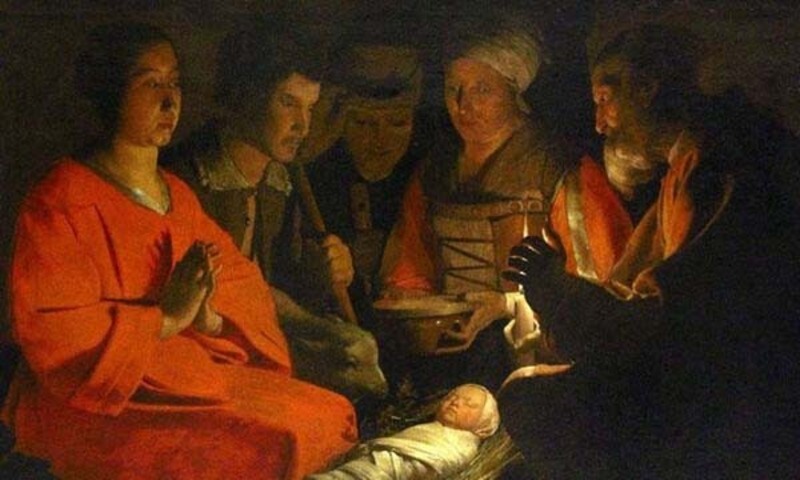Luke tells us that Mary “gave birth to her first-born son and wrapped him in swaddling clothes” (Luke 2:7). Later, the angel told the shepherds that they would “find the baby wrapped in swaddling clothes and lying in a manger” (Luke 2:12).
But what were swaddling clothes? The word is old-fashioned enough that many modern Bibles now translate it with “cloths” or “strips of cloth.” The fact that “swaddling clothes” sounds odd makes some people think that Mary was doing something unusual. For example, some have claimed that swaddling clothes were intended for wrapping newborn lambs or dead bodies. But it turns out that the Greek word used for "swaddling" here in Luke was not an unusual word at all, and it did not refer to wrapping lambs or dead bodies.
To find out what this word meant to ancient Greek-speakers, I used a few databases of ancient Greek literature to find all occurrences of the Greek words σπαργανόω (sparganoō, to wrap in swaddling-clothes) and σπάργανον (sparganon, swaddling clothes). I read through every occurrence of these words from literature written before the New Testament and many from after the New Testament as well.
It turns out that this word was entirely normal. σπαργανόω is a stock word used dozens of times in association with birth and babies. It simply refers to wrapping newborn babies tightly in soft cloths, much like most of us do with babies today. In most of the Greek literature I looked at, σπαργανόω occurs associated with words like “baby,” “give birth,” “wash” and “nurse.” Over and over in ancient literature, birth and swaddling are described in terms much as we find in Luke 2. For example, the physician Galen (2nd century AD) advises that babies “should be wrapped first in swaddling clothes.” The philosopher Plutarch, writing at about the same time as Luke, describes how a new mother “receives her baby with pain and suffering, and with tatters of swaddling clothes she warms and caresses it… both night and day.”
The word σπάργανον was so common that people would often say “in swaddling clothes” (ἐν σπαργάνοις) to mean “still a small baby.” And while we might say “from the cradle” to refer to something we have experienced from birth, Greek speakers often said, “from swaddling clothes” (ἐκ σπαργάνων). Our phrase “from birth to death” was sometimes “from swaddling clothes to death” (ἀπὸ σπαργάνων πρὸς τελειότατον).
So when Mary wrapped Jesus in swaddling clothes, this was a completely normal thing to do. When the angels told the shepherds to look for a baby “wrapped in swaddling clothes,” they were just using ordinary wording to say that he was a newborn. Since Bethlehem was a very small town, he might well have been the only newborn they would find that night; and of course, they could look for the only newborn “lying in a manger.”
Some other interesting facts about ancient swaddling (although not necessarily relevant to the story of Jesus’ birth):
Both Ezekiel (Ezek 16:4) and Galen the physician said that newborn babies were bathed, lightly salted and swaddled. Galen said that the salt was to help in the adjustment from the womb to the air.
Spartan and Scythian mothers reportedly did not swaddle their babies because they wanted their limbs to move freely to prepare them for future combat.
Marcus Cato (2nd century BC senator) was described as a devoted father: “after the birth of his son, nothing could prevent him from being present whenever his wife bathed and swaddled the baby.”
Swaddling clothes also functioned as diapers. In a 5th-century BC play by Aeschylus, a nurse describes how she would try to remove the swaddling clothes quickly to avoid them getting soiled.
Diogenes (4th century BC philosopher) joked that “rich men are like newborn babies — both are in constant need of swaddling clothes.”
Sometimes the ancients described keeping a baby’s swaddling clothes for many years. This seemed to happen especially with abandoned or adopted babies, as the distinctive swaddling clothes could be used to identify the baby.
Hippocrates (4th century BC physician) explained how to fasten a splint on a leg: “just as babies are swaddled.”
King Mithridates of Pontus (1st century BC) was supposedly struck by lightning as an infant. The lightning burned up his swaddling clothes but left him unharmed — except for a scar on his forehead that was always covered by his hair when he was a boy. You may recognize this as the probable inspiration for Harry Potter!
 Biola University
Biola University

.jpg)


